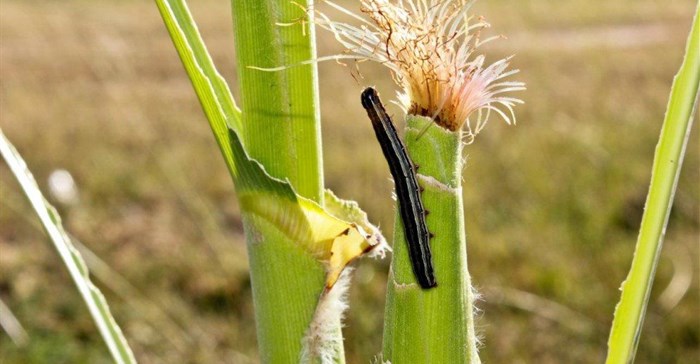When Mutondwa Phophi began undergraduate studies, she wanted to help alleviate the suffering of smallholder farmers from climate change-related impacts and destructive plant pests.
“I have always loved crop protection during my days as an undergraduate student. I enjoyed assisting smallholder farmers on practical issues such as finding ways to improve their yield, and addressing the issues of pests was one of them,” said Phophi, a postdoctoral fellow in crop science at the University of KwaZulu-Natal, in Durban, South Africa.
Phophi is one of many African scientists to conduct research to better understand how climate change and the associated spread of pests are affecting smallholders in Sub-Saharan Africa.
“My goal is to assist farmers in achieving their goal, also contributing to the sustainable development goal of zero hunger,” she said.
In 2016, Phophi conducted a study to find out smallholder farmers’ perceptions of the impacts of climate change on insect pest outbreaks in South Africa’s Limpopo province.
At that time, pests were ravaging vegetable farms in the province, especially tomatoes, with farmers counting losses year in and year out.
The desert locust upsurge in Eastern Africa is the most recent example of how climate change can lead to unprecedented damage - Ivan Rwomushana, Cabi
“I presented my research findings to smallholder farmers as a way of assisting them in what can be done to improve their production,” said Phophi. “I believe all [agricultural] scientists and researchers should give back their findings to farmers.”
Snails and locusts
Ivan Rwomushana, a senior research scientist in invasive species management at the Centre for Agriculture and Bioscience International (Cabi), the parent organisation of SciDev.Net said that climate change in sub-Saharan Africa has been characterised by extreme temperature and rainfall, which makes it a key factor in the surging spread and impact of pests.
Last year, a team of scientists from the Kenya Plant Health Protectorate Service and CABI reported the presence of an invasive golden apple snail in the Mwea rice irrigation scheme in central Kenya. This was the first time that the voracious pest native to the Americas was reported in Africa.
According to a paper published in the journal Nature Climate Change in 2020, the desert locust outbreaks in East Africa “show that the impact of climate change is not merely the consequences of changes in mean temperature, but also of increases in extreme and unprecedented events”.
The paper warned that an increase in cyclone frequency and extreme climate variability “could increase the likelihood of pest outbreaks and spread,” which could compromise food security.
Desert locusts are voracious eaters which feed on crops, grass, shrubs and trees. The wave of infestations are reported to have destroyed 70,000 hectares of farmland in Somalia and Ethiopia in 2019, the researchers said.
Paramu Mafongoya, a professor of agriculture and environmental sciences from the University of KwaZulu-Natal, said that insect pests are estimated to reduce crop production by 25-40%, if not well managed.
Upsurge in pests
Some of these insect pests such as the whitefly, he said, have not been a threat in the past but now pose a serious danger to crops as climate change has led to their increase in survival rates.
“It is a serious issue. Some of these pests are invasive and lack natural enemies in the new areas where they are introduced,” said Mafongoya. “It’s a nuisance, especially to crop production when we have these pests.”
Authorities need to produce risk maps once a pest is reported to guide interventions and control spread. - Paramu Mafongoya, University of KwaZulu-Natal
Rwomushana told SciDev.Net that climate change can affect the population size, survival rate and geographical distribution of pests. The increase in temperature and rainfall provides a warm and humid environment necessary for rapid multiplication of pests, he said.
“The desert locust upsurge in Eastern Africa is the most recent example of how climate change can lead to unprecedented damage. Several rare cyclones struck the Arabian Peninsula leading to unusually wet weather in this region and then eastern Africa, leading to rapid locust proliferation and the subsequent outbreak,” Rwomushana explained.
Meanwhile, warmer weather conditions attributed to climate change are triggering fall armyworm outbreaks in many parts of Sub-Saharan Africa, says Rwomushana. The pest which first invaded Africa in 2016, is estimated to cause 8-20 million tonnes of maize losses each year.
An increase in pests such as the Asian fruit fly, papaya mealybug, tomato leaf miner, larger grain borer and red palm weevil has also been linked to climate change, he adds.
Populations of pests affecting animals, such as ticks that transmit East Coast fever, are also increasing in warmer temperatures, notes Mafongoya, but remain largely ignored by researchers.
Border surveillance
The spread of invasive species across Sub-Saharan Africa is expedited by porous borders with poor phytosanitary checks, say the scientists. They believe this needs to be addressed as a priority, rather than relying on the extensive use of chemicals.
“Pests are now becoming resistant to pesticides, making it difficult to control them,” said Phobi, adding that farmers at an irrigation scheme in northern South Africa planting cucumbers and tomatoes had to abandon their farms after the whitefly pest became resistant to the pesticides, causing them losses.
“Today, the whitefly is found throughout the year because of warmer conditions even during the winter season. The population has therefore risen making it extremely difficult for farmers to control it,” she added.
Mafongoya urges governments to boost cross-border surveillance and phytosanitary capacity at the borders to ensure limiting of the spread of invasive pests.
“We also need inter-regional research to find sustainable solutions to control these pests,” Mafongoya said. “Authorities need to produce risk maps once a pest is reported to guide interventions and control spread.”
Phobi called for the training of agricultural extension officers, especially on managing invasive pests at the farm level. Drawing from the experience of her doctoral studies, she said that most extension officers are not well trained, especially on climate change issues, making it difficult to translate knowledge on control measures.
Rwomushana recommends the production of clean seed and planting material, early warning systems, use of biological crop-protection products, and good diagnostic tools as the best practices for managing pests.
This piece was produced by SciDev.Net’s Sub-Saharan Africa English desk.

























